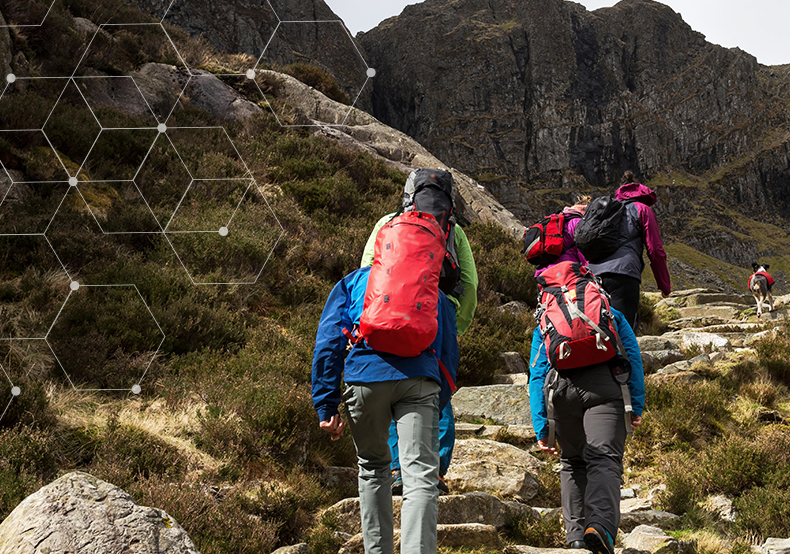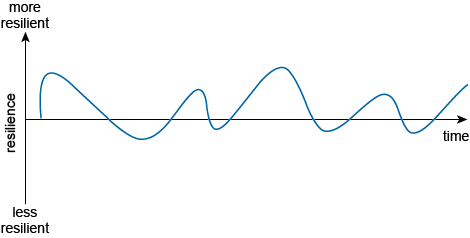2.8 Resilience
According to Lucy Hone (TED, 2019), we have all had to deal with some tough times at some point and how we deal with them is through resilience. Psychology Today defines it in the following way:
Resilience is that ineffable quality that allows some people to be knocked down by life and come back stronger than ever. Rather than letting failure overcome them and drain their resolve, they find a way to rise from the ashes.
Resilience is defined as our ability or tendency to adapt and ‘bounce back’ when things don’t go as planned, and being resilient is having the ability to learn from mistakes and then to grow.
When the COVID-19 pandemic started in March 2020 and people were told to work from home, there were many examples of people bouncing back and even thriving in unfamiliar situations. New businesses were started in fact; according to Jones (2021), the UK saw a 14% increase in new businesses despite the pandemic. People like Bora Kirgiz [Tip: hold Ctrl and click a link to open it in a new tab. (Hide tip)] turned from a disillusioned taxi driver to open up Bona Couple Cafe & Lounge.
The phrase ‘bouncing back’ is an interesting concept as instead of giving up in the face of adversity, we get back up and get on with things. This short video of young children trying to knock a toy down provides a vivid illustration of this: A lesson on resilience.
Activity 13 Strengths of resilient people
Take a few minutes to think about someone you know, or a well-known person, whom you think of as resilient. Consider in what way, or in what type of situation, they are resilient, and what strengths they show.
Which of the following qualities do they demonstrate?
- confidence
- problem-solving
- a positive outlook
- forward thinking
- a good planner
- a good communicator
- comfortable with their emotions
- intelligence.
Which others would you add?
| Name of resilient person | |
| Characteristics |
Developing career resilience
Another familiar example of a resilient type of person is an athlete. Watch this short video to see how British gold medal winning sprinter and former gymnast Asha Philip approaches resilience: Asha Philip on resilience.
While we won’t all need to demonstrate this level of resilience in our lives, we can learn some lessons from Asha’s journey. She talks about the importance of having the belief of others, taking things step by step, mental toughness, and seeing change or adversity as an opportunity to learn more about yourself. Those lessons can be applied in many different situations.
Resilience strategies
Everyone has the capacity for resilience and an extreme example is given by Lucy Hone during a TEDx talk: The three secrets of resilience people
In summary, Hone describes how she lost her 12 year old daughter in a car crash, how this caused trauma and disruption in her life, and that the support she received at the time left her feeling powerless and like a victim. She advises that there are three strategies or secrets of resilient people:
- acceptance/acknowledgement of the situation as part of your life
- selectional attention (focus on the things you can change/that are in your sphere of influence and on the positive things)
- control over the situation and being kind to yourself – think ‘is what you are doing helping or harming you?’.
Is resilience in our DNA?
Looking at the specific characteristics that enable some people to be more resilient than others helps us to think about why some people show greater degrees of resilience than others when faced with a similar situation.
But why do individuals develop these characteristics differently? Advances in genetic research over the last ten years have linked various genes to a range of social behaviours. Are genes also linked to our ability to cope with life’s challenges?
Activity 14 In the blood?
Watch the video ‘In the blood’ with Simon Weston. You can read the transcript for the video here.
Weston is a veteran of the British Army who became well known throughout the UK for his charity work after he suffered severe burn injuries during the Falklands War. In the video he visits the Genome Centre in London to meet psychologists Dr Michael Pluess and Dr Aneta Tunariu and to see if he has the resilience gene.
Note down how Weston explains his ability to be resilient.
Did the video have any broader messages for you?
While the scientific community is still divided on the genetic component of mental resilience, psychologists have highlighted the importance of training ourselves to be more resilient.
Can you learn to be more resilient?
Psychologists have argued for more than 100 years that early childhood socialisation has a significant impact on the way that individuals relate to others later in life. This socialisation also supports our resilience, through:
- strong and supportive family relationships
- family social networks that extend into the community
- the development of good communication skills
- the ability to show empathy to others
- sociability, i.e. a liking for developing new social relationships.
Of course, our liking for social relationships is also connected to our personality characteristics. Some people are more sociable than others. This will be explored in the next activity.
Activity 15 Sociability and social networks
Watch the video Resilience: personality and note how chartered psychologist Professor Ivan Robertson explains how resilience is connected to our ability to develop social relationships.
Consider what his explanation means for you. Can you identify whether your personality type might have a positive impact on your resilience? Or might you need to find other ways to develop it? Make some notes in the box below.
You might think that if the personality characteristics that we are born with play such a key part in our resilience, it can’t be learned after all.
However, CEO Genie Joseph, founder of ACT RESILIENT, disagrees. She outlines three types of resilience that she has identified through her work with US military personnel and their families (Joseph, 2012). They are:
- Natural resilience – the resilience you are born with. It protects us and encourages us to play and learn and explore our world.
- Adaptive resilience – which occurs when challenging circumstances cause you to adapt and grow, becoming stronger and more resilient because of what you have encountered.
- Restored resilience – also known as learned resilience. This means you can learn techniques that can restore the natural resilience we had as children.
The implication here is that through adaptive and restored resilience we can certainly learn techniques and build habits that will support us in developing and enhancing our resilience further.
One thing we can certainly do to support our own resilience is build caring and supportive relationships around us.
In the earlier clip Professor Robertson talked of the importance of social support networks, or the ability to develop them, in helping resilience. Simon Weston also talked about the support of his family and friends contributing to his resilience. According to the American Psychological Association (2014), many studies show that the primary factor in personal resilience is having caring and supportive relationships within and outside the family. These relationships create love and trust, provide role models and offer encouragement and reassurance. This helps to bolster a person’s resilience, particularly in times of difficulty.
So, in summary, while personality traits and strong support networks clearly have an influence on how resilient we are, resilience is also a skill that can be learned and developed.
You’ll explore strategies for developing your own resilience later in the course.
Resilience over time
Below is an image which shows a fictional person’s resilience through time and how that can vary. This is an important consideration, as it can help you see that it is normal to feel more or less resilient at different times of your life.
Activity 16 Your resilience timeline
If you had to draw an image to represent your own resilience timeline, what would that look like? How has your resilience level been affected by the COVID-19 pandemic – especially the periods of lockdown – or by moving to remote and hybrid working?
Try drawing a timeline like the example shown above to illustrate variations in your personal resilience over time. Use pen and paper or your preferred digital tool.
This might seem like a daunting task at first, so one way to start might be to divide the line into decades of your life. Then you can identify the points at which you have felt most in control of your life, able to meet and deal with challenges. Follow that by thinking about the points in your life where you have felt less resilient, and then join the points to create your resilience timeline.
Use the timeline to reflect on:
- a time when you may have moved from a feeling of helplessness about a situation to a feeling of control and optimism about the future.
- the relationships or circumstances that have made a difference for you – for example, working remotely might have removed you from the support networks you had with work colleagues, or alternatively, it might have introduced you to new support networks and digital tools that you didn’t have before.
- whether there is anything from your past experience that you should reintroduce into your life to enhance your resilience now.


